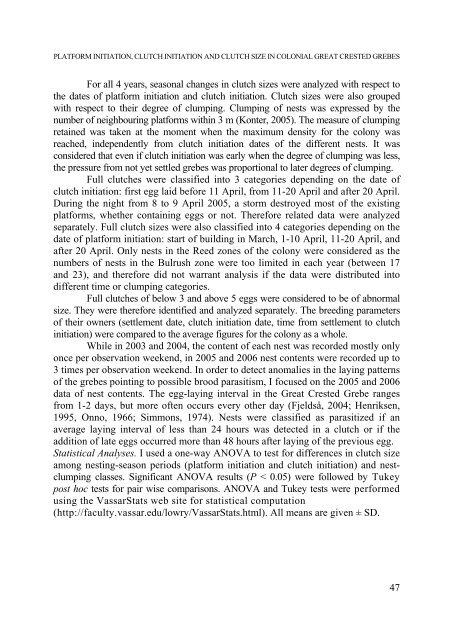biologia - Studia
biologia - Studia
biologia - Studia
You also want an ePaper? Increase the reach of your titles
YUMPU automatically turns print PDFs into web optimized ePapers that Google loves.
PLATFORM INITIATION, CLUTCH INITIATION AND CLUTCH SIZE IN COLONIAL GREAT CRESTED GREBES<br />
For all 4 years, seasonal changes in clutch sizes were analyzed with respect to<br />
the dates of platform initiation and clutch initiation. Clutch sizes were also grouped<br />
with respect to their degree of clumping. Clumping of nests was expressed by the<br />
number of neighbouring platforms within 3 m (Konter, 2005). The measure of clumping<br />
retained was taken at the moment when the maximum density for the colony was<br />
reached, independently from clutch initiation dates of the different nests. It was<br />
considered that even if clutch initiation was early when the degree of clumping was less,<br />
the pressure from not yet settled grebes was proportional to later degrees of clumping.<br />
Full clutches were classified into 3 categories depending on the date of<br />
clutch initiation: first egg laid before 11 April, from 11-20 April and after 20 April.<br />
During the night from 8 to 9 April 2005, a storm destroyed most of the existing<br />
platforms, whether containing eggs or not. Therefore related data were analyzed<br />
separately. Full clutch sizes were also classified into 4 categories depending on the<br />
date of platform initiation: start of building in March, 1-10 April, 11-20 April, and<br />
after 20 April. Only nests in the Reed zones of the colony were considered as the<br />
numbers of nests in the Bulrush zone were too limited in each year (between 17<br />
and 23), and therefore did not warrant analysis if the data were distributed into<br />
different time or clumping categories.<br />
Full clutches of below 3 and above 5 eggs were considered to be of abnormal<br />
size. They were therefore identified and analyzed separately. The breeding parameters<br />
of their owners (settlement date, clutch initiation date, time from settlement to clutch<br />
initiation) were compared to the average figures for the colony as a whole.<br />
While in 2003 and 2004, the content of each nest was recorded mostly only<br />
once per observation weekend, in 2005 and 2006 nest contents were recorded up to<br />
3 times per observation weekend. In order to detect anomalies in the laying patterns<br />
of the grebes pointing to possible brood parasitism, I focused on the 2005 and 2006<br />
data of nest contents. The egg-laying interval in the Great Crested Grebe ranges<br />
from 1-2 days, but more often occurs every other day (Fjeldså, 2004; Henriksen,<br />
1995, Onno, 1966; Simmons, 1974). Nests were classified as parasitized if an<br />
average laying interval of less than 24 hours was detected in a clutch or if the<br />
addition of late eggs occurred more than 48 hours after laying of the previous egg.<br />
Statistical Analyses. I used a one-way ANOVA to test for differences in clutch size<br />
among nesting-season periods (platform initiation and clutch initiation) and nestclumping<br />
classes. Significant ANOVA results (P < 0.05) were followed by Tukey<br />
post hoc tests for pair wise comparisons. ANOVA and Tukey tests were performed<br />
using the VassarStats web site for statistical computation<br />
(http://faculty.vassar.edu/lowry/VassarStats.html). All means are given ± SD.<br />
47
















